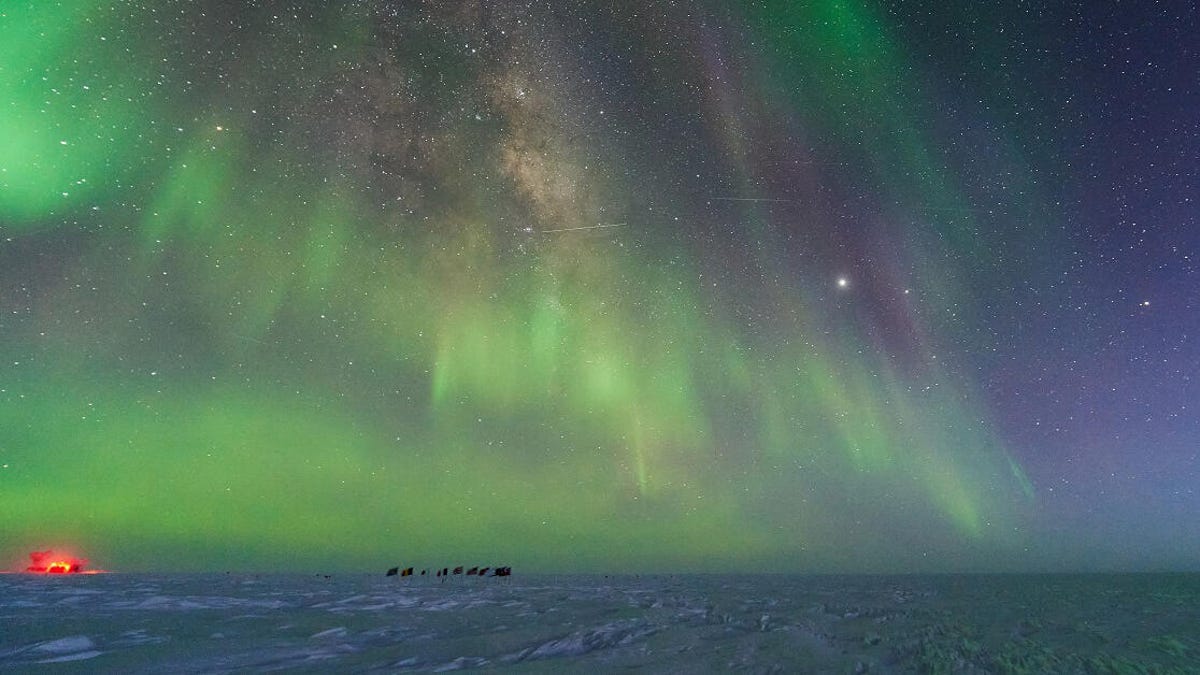Scientists pinpoint the best place on Earth to see the cosmos at night
If you want to see the wonders of the universe, the best place on the planet is also one of the most remote -- and one of the coldest.

Aurora and stars, as seen from the US Amundsen-Scott South Pole Station in July 2020
If you want to get the best possible view of the stars from down here on Earth, you need to prepare for a long journey to the coldest place on the planet. Around 650 miles inland from Antarctica's eastern edge you'll find yourself upon a pristine-white plateau, stretching to the horizon: Dome A.
A new study performed by Chinese researchers at the research station located at Dome A, published in the journal Nature on Wednesday, suggests it could be the best place on Earth for astronomers to survey the skies. But you have to get there first.
The trek to Dome A is intense.
First, you've got to get to Antarctica. Not that difficult these days, but you need to take an icebreaker so you can be dropped off at the East Antarctic shoreline. A helicopter carries you from the ship onto the icy continent, and then the real journey begins. From there, you make your way across the ice in a shipping container-like vehicle, pulled by a tractor at around 6 miles (10 kilometers) per hour. It takes about two weeks to arrive at your destination.
Only then can you begin to set up your telescope on an eight-meter-high platform in the middle of the ice desert.
That's exactly what the team of researchers did during the 2018-19 summer -- and they report that the atmospheric conditions are so good their views of the night sky are unlike those anywhere else on Earth.
"The experience was unique and exciting," says Zhaohui Shang, one of the researchers who was part of the expedition and co-author on the study. "We had very intense work to complete, with only about 3 weeks in summer at Dome A."
The location of Dome A.
Immaculate sky
Dome A has long been considered a great place for star-gazing. But what makes the coldest place on Earth particularly good for seeing the cosmos?
"It comes down to the atmospheric turbulence," explains Michael Ashley, an astrophysicist at the University of New South Wales and co-author on the study.
"If you go to a good dark site somewhere, you see the stars twinkling and the twinkling is bad."
The twinkling, Ashley says, is caused by Earth's atmosphere and isn't helpful for astronomers trying to image the cosmos. But in Antarctica, there's very little turbulence, because it's so flat and the winds that move across the area are extremely light.
"If you just have winds blowing across a dead-flat snow surface, there's no opportunity for turbulence to be generated," he explains.
Ice to see you: the telescope set up at Dome A.
In addition, water vapor can play havoc with astronomy because it absorbs light, particularly in infrared wavelengths. But Antarctica is very dry -- the water freezes out -- and that's a huge advantage for those looking to study the sky. Particularly if you want to study the the cosmos in the millimeter wavelength, like the Atacama array in the Chilean desert does.
"We have taken a terahertz telescope there and got spectacular data," says Ashley.
"And we're much better than Atacama in terms of site conditions."
The observations from telescopes at Dome A are around two and a half times better than what you might see at some of the best Earth-based observatories in Chile or Hawaii.
China plans to build another infrared optical telescope at the site known as the Kunlun Dark Universe Survey Telescope, KDUST. It's been in the works for about a decade and would see China place a telescope, almost two times as big, at the location.
"At the moment, it's kind of stalled in a review," says Ashley. "I think they're looking at it very closely. And I think this Nature paper should go quite some way to giving it a bit of a push."
China's recent scientific endeavors extend well beyond the Earth, too. Last week, the country launched the Tianwen-1 mission. A spacecraft, carrying three robotic explorers, is en route to Mars and is expected to arrive there in February 2021.

